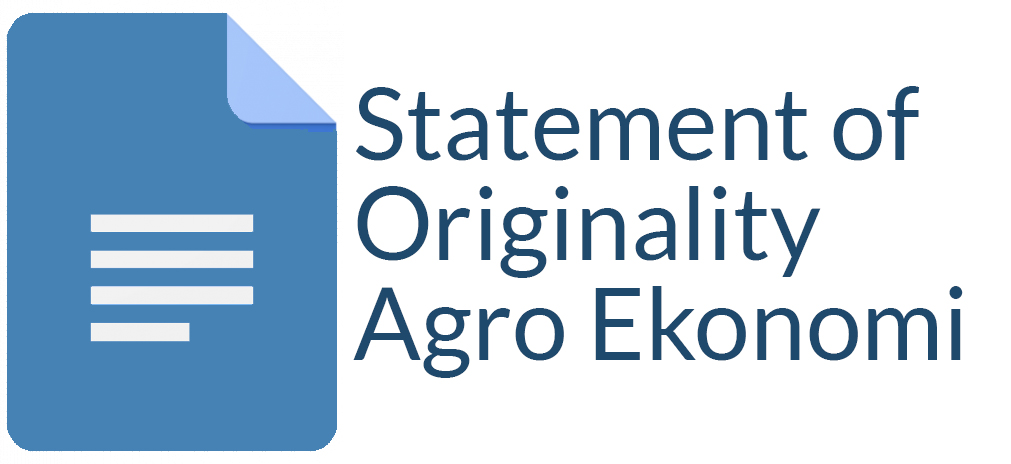Characteristics of Young Horticultural Farmers in Malang Regency
Eri Yusnita Arvianti(1*), Masyhuri Masyhuri(2), Lestari Rahayu Waluyati(3), Dwidjono Hadi Darwanto(4)
(1) Doctoral Student in Agricultural Economics, Faculty of Agriculture, Universitas Gadjah Mada
(2) Department of Socioeconomics, Faculty of Agriculture, Universitas Gadjah Mada
(3) Department of Socioeconomics, Faculty of Agriculture, Universitas Gadjah Mada
(4) Universitas Gadjah Mada
(*) Corresponding Author
Abstract
The horticulture subsector occupies a strategic position in the development of Indonesia's agriculture sector. Farmers have an important role in developing agriculture and promoting the agricultural sector in Indonesia. Therefore this paper aims (1) to find out the distribution of characteristics of young farmers in Malang Regency, (2) to know the managerial capacity and empowerment of young farmers in horticultural agriculture in Malang Regency. This research was conducted in five villages in Malang Regency in 2018. These villages were Codo Village, Dampit Village, Punten Village, Gempol Village, and Ngantru Village. The sample is determined by census with a sample size of 195. The analytical method used is descriptive method. Data obtained using interviews through questionnaires. The results showed that the characteristics of young horticultural farmers in Malang Regency were mostly in their 30s and men. The level of education of young horticultural farmers is still low and on average has 9 years of agricultural experience with low land ownership. An intensive policy is needed for young farmers in terms of land ownership. Most farmers have used cellphones or gadgets to carry out agricultural transactions. Most young horticultural farmers in Malang Regency already have good managerial capacity, but in terms of empowerment is still not optimal. The government and farmer groups need to increase their role in supporting the agriculture of young horticultural farmers to be more developed so that young farmers in Malang Regency do not leave their jobs in the agricultural sector.
Keywords
Full Text:
PDFReferences
Adawiyah, C. R., Sumardjo, & Mulyani, E. S. (2017). Faktor-faktor yang mempengaruhi peran komunikasi kelompok tani dalam adopsi inovasi teknologi upaya khusus (padi, jagung, dan kedelai) di Jawa Timur. Jurnal Agro Ekonomi, 35(2), 151–170.
Asih, D. N. (2009). Analisis karakteristik dan tingkat pendapatan usahatani bawang merah di Sulawesi Tengah. Jurnal Agroland, 16(1), 53–59.
BPS. (2015). Statistik Hortikultura Provinsi Jawa Timur. Jawa Timur: Badan Pusat Statistik Provinsi Jawa Timur.
BPS. (2018). Hasil Survei Pertanian Antar Sensus (SUTAS) 2018. Jakarta.
Cavicchioli, D., Bertoni, D., & Pretolani, R. (2018). Farm Succession At A Crossroads : The Interaction Among Farm Characteristics , Labour Market Conditions , and Gender And Birth Order Effects. Journal of Rural Studies, 61(2018),
Felicia, W. I., Emmanuel, F. O., & Olaseinde, A. T. (2016). Assessing The Future Of Agriculture in The Hands of Rural Youth in Oriade Local Government Area of Osun State , Nigeria. International Journal of Agricultural Extension, 04(02), 105–110.
Hamilton, W., Bosworth, G., & Ruto,E. (2015). Entrepreneurial Younger Farmers and The “Young Farmer Problem” in England. Agriculture & Forestry, 61(4), 61– 69. https://doi.org/10.17707/ Agricult Forest.61.4.05
Iriyani, D., & Nugrahani, P. (2017). Karakteristik Petani Sayuran Periurban Kota Surabaya. Prosiding Seminar Nasionsl Tahunan Matematika, Sains, Dan Teknologi Universitas Terbuka Convention Center, 105–118.
Katchova, A. L., & Ahern, M. (2014). Farmland Ownership and Leasing : Implications for Young and Beginning Farmers (No. 486). Kentucky.
Mahudin, F. N., & Shabahati, I. (2017). Krisis Petani Muda Masa Depan. Kinerja Logistik Indonesia Hingga Kini, II(21), 3–8.
May, D., Arancibia, S., Behrendt, K., & Adams, J. (2019). Preventing Young
Farmers from Leaving The Farm : Investigating The Farm Effctiveness of The Young Farmer Payment Using A Behavioural Approach. Land Use Policy, 82(2019), 317-327. https://doi.org/10.1016/j.landusepol.2018.12.019
Mukti, G. W., Andriani, R., Kusumo, B., & Qanti, S. R. (2017). Perilaku Sukses Petani Muda Wirausaha Lulusan Fakultas Pertanian Universitas Padjadjaran. Jurnal Agribisnis TErpadu, 10(2), 221–234.
Murphy, D. (2012). Young Farmer Finance Schemes. Australia. Nazir, M. (2005). Metode Penelitian. Bogor: Ghalia Indonesia.
Nugroho, A. D., & Waluyati, L. R. (2018). Upaya Memikat Generasi Muda Bekerja pada Sektor Pertanian di Daerah Istimewa Yogyakarta Efforts of Engage Youth Generation to Working on Agricultural Sector in Yogyakarta Province. Jurnal Ilmu Pemerintahan Dan Sosial Politik UMA, 6(1), 76–95.
Pardian, P., Rasmikayati, E., Djuwendah, E., & Saefudin, B. R. (2017). Persepsi dan Minat Petani Muda Dalam Budidaya Sayuran Swiss Chard Organik. Jurnal Aplikasi Ipteks Untuk Masyarakat, 6(3), 163–166.
Pujiriyani, D. W., Suharyono, S., Hayat, I., & Azzahra, F. (2016). Sampai Kapan Pemuda Bertahan di Pedesaan? Kepemilikan Lahan dan Pilihan Pemuda untuk Menjadi Petani.
Bhumi, 2(2), 209–226.
Puspitawati, H., Herawati, T., & Sarma, M. (2018). Reliabilitas dan Validitas
Indikator Ketahanan Keluarga di Indonesia. Jurnal Kependudukan Indonesia, 13(1), 1–14.
Rovny, P. (2016). The Anaysis of Farm Population With Respect to Young Farmers in The European Union. Procedia Social and Behavioral Sciences, 220(2016), 391–398. https://doi.org/10.1016/j.sbspro.2016.05.513
Saiyut, P., Bunyasiri, I., & Sirisupluxana, P. (2017). Kasetsart Journal of Social Sciences The Impact of Age Structure on Technical Efficiency in Thai Agriculture. Kasetsart Journal
of Social Sciences, xxx(2017), 1–7. https://doi.org/10.1016/j. kjss.2017.12.015
Silva, J. L. D., Shaffril, H. A. M., Uli, J., & Samah, B. A. (2009). A Review of Contract Farming and Factors that Impinge Youths Acceptance to Contract Farming. European Journal of Social Sciences, 11(2), 328–338.
Susilowati, S. H. (2016). Femomena Penuaan Petani dan Berkurangnya Tenaga Kerja Muda serta Implikasinya bagi Kebijakan Pembangunan Pertanian. Forum Penelitian Agro Ekonomi, 34(1), 35–55.
Uchiyama, T. (2014). Recent Trends in Young People’s Entry into Farming in Japan: An International Perspective. In Enhanced Entry of Young Generation into Farming
(pp. 1–14). Jeonju: FFTC-RDA International Seminar.
Umunnakwe, V. C., Pyasi, V. K., & Pande, A. K. (2014). Factors influencing involvement in agricultural livelihood activities among rural youth in Jabalpur district of. International Journal of Agricultural Policy and Research, 2(August), 288–295.
Zagata, L., & Sutherland, L. (2015). Deconstructing the ‘ young farmer problem in Europe ’ : Towards a research agenda. Journal of Rural Studies, 38(2015), 39–51. https://doi.org/10.1016/j.jrurstud.2015.01.003
Article Metrics
Refbacks
- There are currently no refbacks.
Copyright (c) 2018 Agro Ekonomi

This work is licensed under a Creative Commons Attribution-ShareAlike 4.0 International License.
View My Stats











